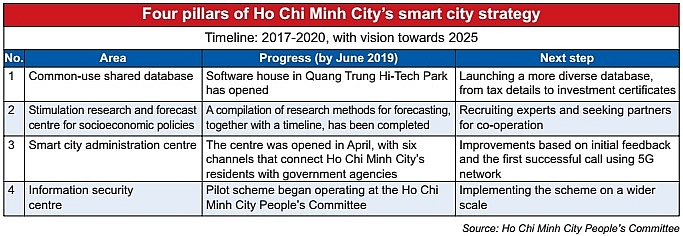Smarter transport for Ho Chi Minh City
 |
| Ho Chi Minh City will approach smart transportation from four different angles at the same time |
Ho Chi Minh City, which holds more than 10 million residents, is a hotspot for traffic woes. From traffic jams that lock down the city during rush hours and cause toxic car emissions to inadequate public transport, city residents complain on a daily basis that traffic problems have undermined their quality of life.
This is why transportation is an important aspect of Ho Chi Minh City’s smart city strategy, which began in 2017 and has a vision towards 2025. In general, the strategy aims to adopt Industry 4.0 technologies in everyday life in the city, including a shared public database, administration centres, an information security centre, and a research and forecast institution.
The city has set up the Centre for Smart Transport Monitoring and Control as part of its smart city strategy. The first phase for the centre began before the 2019 Lunar New Year, covering the four areas of traffic monitoring, traffic information, traffic control, and resolving traffic accidents or violations.
For the purposes of monitoring, the centre makes use of 762 surveillance cameras scattered around the city, together with over 60 high-definition screens for viewing. For traffic control, officials rely on 216 traffic light booths located on 78 major streets in inner city districts. There are also 28 booths for thoroughfares such as Vo Van Kiet, Mai Chi Tho, and Dong Van Cong.
At least 70 digital signs conveying traffic information have been installed, helping city residents plan their routes. They can also access Ho Chi Minh City Department of Transport’s (DoT) website for real-time data on traffic congestion, as well as information on petrol stations, construction, or parking areas. The website has a smartphone application version, making it more accessible for time-poor and tech-savvy urbanites.
When it comes to solving traffic accidents and identifying violations, data is collected through nine automatic speed-checking devices, together with six automatic freight-checking machines. The data is then sent to the DoT and relevant authorities for fines, if applicable.
“Instead of using police officers or volunteers at each and every traffic light, we can now use the data analysed at the centre and make an immediate response for the entire area. This is much more efficient than the traditional method,” said Le Minh Triet, CEO of Ho Chi Minh City Urban Railways No.1 Co., Ltd.
In the next stage, which will be implemented next year, the city will launch its Intelligent Transport System (ITS). According to its website, the $250 million ITS uses smart technology to manage transport infrastructure and enhance capacity management, ensuring traffic safety and promoting sustainability.
To carry out these goals, the ITS will introduce a smart toll collection system, together with bus rapid transit, vehicle weight solution providers, LED panels, red-light enforcement systems, and traffic flow monitoring, according to the Innovative Technology Corporation.
So far, numerous foreign investors and consultants have offered to assist Ho Chi Minh City in its quest for better traffic management, including those from Sweden, the United Kingdom, and Japan.
 |
Money matters
Among the various traffic issues that Ho Chi Minh City is trying to tackle in its smart city strategy, payment has emerged as an indispensable field of focus. In developed cities around the world, digital payment has propelled the use of public transport thanks to the ease and convenience it offers to passengers.
A notable example is Transport for London in the UK. Statistics show that 2.5 million contactless journeys are made across bus, tube, and rail services every day. Since 2016 the proportion of pay-as-you-go journeys made through London’s contactless systems has risen from 25 per cent to over 50 per cent of the total.
Various reasons have been put forward for the London success story. First, the underlying technology, such as chip cards based on Europay, Mastercard, and Visa (EMV) standards are already there. Second, Transport for London has enabled contactless payments across all modes of transit, making it convenient for riders.
Similarly, since June 6, users of public transport in Singapore can enjoy hassle-free contactless payments through Simlygo, which in April was extended to include Visa. The company now expects the move to push contactless penetration even above the current 80 per cent rate.
When combined with the shift to mobile and wearables, contactless payments become even more helpful and passengers may not need to carry their wallet at all.
In the Asia-Pacific region, early success stories have also emerged. Australia is piloting contactless EMV card acceptance on Sydney ferries and light rail, while Myanmar, Thailand, and Singapore have made public announcements about contactless EMV transit strategies.
If passengers in Vietnam can start using their contactless EMV cards to pay, regardless of which bank issued their card or what mode of transportation they are travelling on, it would support the wider adoption of contactless payments. Physical wallets may be phased out entirely.
Key partnership with Visa
It is clear that Ho Chi Minh City’s DoT is taking notice of worldwide trends. On August 7, the DoT signed a memorandum of understanding to drive development and adoption of digital payments to achieve smart mobility in the city. As part of this, Visa and the DoT intend to collaborate to increase the acceptance of digital payments and implement a secure open-loop system across all transportation networks.
These initiatives include leveraging Visa’s feasibility study on the transit payment system in Ho Chi Minh City to help educate stakeholders and guide the future direction of the transit and transit-adjacent payments infrastructure.
Visa also intends to work with the DoT to explore opportunities to upgrade the legacy closed-loop payment system by adopting an open-loop EMV contactless technology for all transportation networks – similar to what other cities around the globe are carrying out.
“We are looking forward to bringing our expertise in digital payments and urban mobility to this partnership in the hope that we can accelerate Ho Chi Minh City’s smart mobility plans, providing people with secure, faster, and more convenient ways to pay for their transport and everyday purchases,” said Dang Tuyet Dung, country manager for Visa Vietnam and Laos.
Finally, Visa intends to share best practices with the DoT through knowledge-sharing workshops and a study tour to meet with transport authorities to share experience on delivering smart mobility solutions.
The agreement also positions Visa as the DoT’s preferred partner in developing digital payment solutions for Ho Chi Minh City and outlines a series of initiatives they will be focusing on. So far, the company has carried out 100 projects with public transport operators or authorities across the globe.
What the stars mean:
★ Poor ★ ★ Promising ★★★ Good ★★★★ Very good ★★★★★ Exceptional
Related Contents
Latest News
More News
- Home Credit Vietnam brings financial literacy closer to women and students (November 20, 2025 | 11:25)
- MB partners with Visa, KOTRA to launch new MB Visa Hi BIZ card (November 20, 2025 | 11:24)
- VPBank upgrades core banking with Temenos and Systems Limited (November 14, 2025 | 17:54)
- CPO Home Credit shares how to build an AI-driven but human-centric workplace (October 30, 2025 | 09:56)
- VIB hits $267.4 million in pre-tax profit over first nine months (October 29, 2025 | 12:12)
- UOB Vietnam elevates retail banking experience with enhanced credit card suite (October 24, 2025 | 09:50)
- PVcomBank offers 20 per cent cashback on VNPAY-QR payments (October 20, 2025 | 17:43)
- Vietnam’s banking sector enters data-driven era (September 30, 2025 | 16:33)
- Ant International becomes first foreign partner of China’s CPG (September 22, 2025 | 17:58)
- VIB unveils Smart Duo to maximise savings and spending returns (September 22, 2025 | 11:22)

 Tag:
Tag:





















 Mobile Version
Mobile Version